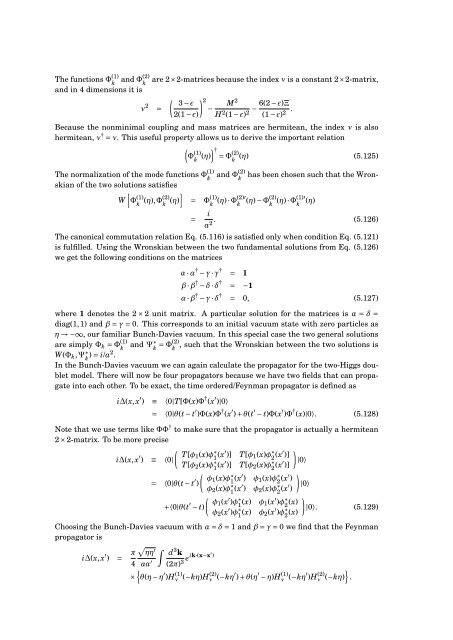Master's Thesis in Theoretical Physics - Universiteit Utrecht
Master's Thesis in Theoretical Physics - Universiteit Utrecht
Master's Thesis in Theoretical Physics - Universiteit Utrecht
You also want an ePaper? Increase the reach of your titles
YUMPU automatically turns print PDFs into web optimized ePapers that Google loves.
The functions Φ (1)kand <strong>in</strong> 4 dimensions it isand Φ(2)kare 2×2-matrices because the <strong>in</strong>dex ν is a constant 2×2-matrix,ν 2 =( ) 3 − ɛ 2M 2 6(2 − ɛ)Ξ−2(1 − ɛ) H 2 −(1 − ɛ)2(1 − ɛ) 2 .Because the nonm<strong>in</strong>imal coupl<strong>in</strong>g and mass matrices are hermitean, the <strong>in</strong>dex ν is alsohermitean, ν † = ν. This useful property allows us to derive the important relation( )Φ (1) †k (η) = Φ(2)(η) (5.125)kThe normalization of the mode functions Φ (1) and Φ(2) has been chosen such that the Wronskianof the two solutions satisfiesk k[]W Φ (1)k (η),Φ(2) k (η) = Φ (1) (η) · Φ(2)′ (η) − Φ(2) (η) · Φ(1)′k k k k(η)i=a 2 . (5.126)The canonical commutation relation Eq. (5.116) is satisfied only when condition Eq. (5.121)is fulfilled. Us<strong>in</strong>g the Wronskian between the two fundamental solutions from Eq. (5.126)we get the follow<strong>in</strong>g conditions on the matricesα · α † − γ · γ † = 1β · β † − δ · δ † = −1α · β † − γ · δ † = 0, (5.127)where 1 denotes the 2 × 2 unit matrix. A particular solution for the matrices is α = δ =diag(1,1) and β = γ = 0. This corresponds to an <strong>in</strong>itial vacuum state with zero particles asη → −∞, our familiar Bunch-Davies vacuum. In this special case the two general solutionsare simply Φ k = Φ (1) and Ψ ∗ kk = Φ(2) , such that the Wronskian between the two solutions iskW(Φ k ,Ψ ∗ k ) = i/a2 .In the Bunch-Davies vacuum we can aga<strong>in</strong> calculate the propagator for the two-Higgs doubletmodel. There will now be four propagators because we have two fields that can propagate<strong>in</strong>to each other. To be exact, the time ordered/Feynman propagator is def<strong>in</strong>ed asi∆(x, x ′ ) ≡ 〈0|T[Φ(x)Φ † (x ′ )|0〉= 〈0|θ(t − t ′ )Φ(x)Φ † (x ′ ) + θ(t ′ − t)Φ(x ′ )Φ † (x)|0〉. (5.128)Note that we use terms like ΦΦ † to make sure that the propagator is actually a hermitean2 × 2-matrix. To be more precise(i∆(x, x ′ T[φ1 (x)φ ∗) ≡ 〈0|1 (x′ )] T[φ 1 (x)φ ∗ )2 (x′ )]T[φ 2 (x)φ ∗ 1 (x′ )] T[φ 2 (x)φ ∗ |0〉2 (x′ )](= 〈0|θ(t − t ′ φ1 (x)φ ∗)1 (x′ ) φ 1 (x)φ ∗ )2 (x′ )φ 2 (x)φ ∗ 1 (x′ ) φ 2 (x)φ ∗ |0〉2 (x′ )(+〈0|θ(t ′ φ1 (x ′ )φ ∗− t)1 (x) φ 1(x ′ )φ ∗ 2 (x) )φ 2 (x ′ )φ ∗ 1 (x) φ 2(x ′ )φ ∗ 2 (x) |0〉. (5.129)Choos<strong>in</strong>g the Bunch-Davies vacuum with α = δ = 1 and β = γ = 0 we f<strong>in</strong>d that the Feynmanpropagator isi∆(x, x ′ ) = π √ηη′ ∫ d 3 keik·(x−x′ )4 aa ′ (2π){3× θ(η − η ′ )H (1)ν (−kη)H(2) ν (−kη′ ) + θ(η ′ − η)H (1)ν (−kη′ )H (2)ν}. (−kη)
















